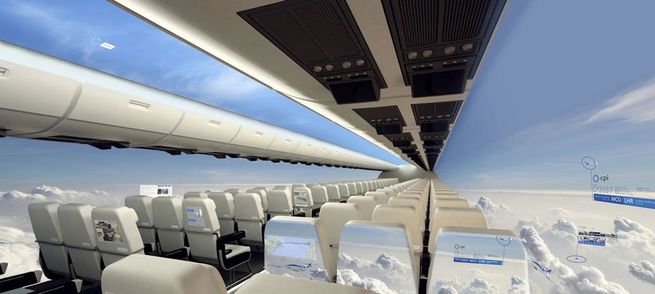Air travel has not only shortened the distances but has always been an adventurous expedition to travel in air. Millions of people all over the world are enjoying air-travel to reach to their destinations in a possible shortest time and with maximum comfort. However, cost and safety are still the points of concern regarding air travel. Frequent air travelers however sometimes put the joy of air travel to question as they mention that passengers are booked inside a box with facilities with limited opportunity to be a part of their surroundings. To overcome or to meet such expectations along with other possible benefits, aero-plane designing and manufacturing companies are coming with the ideas of windowless planes in near future. Thus, the windowless plane will not only squeeze the last drops of joy out of air travel but will be more fuel efficient and thus making air travel cheaper. No windows mean less weight in the fuselage, making them cheaper to fuel and fly. All those lovely memories of faces glued to tiny holes trying to get a final glimpse of a lover or family members before departing will be redundant.
The future of flying sees a visual shift with no-window planes. The aircraft of the future isn’t significantly different to the current model – on the outside at least. Passengers will still be crammed into a ridiculous tin can that moves through the clouds filled with people’s hopes and dreams. And after a few hours of plane food, some pretty interesting smells as well. It is a glimpse into the future that will inspire wonder in some people but perhaps strike terror into the heart of the nervous flyer. A windowless plane will allow passengers to see what’s going on outside, as well as checking their email and surfing the net. In a vision of what the next generation of commercial aircraft could look like in little more than a decade, windows would be replaced by full-length screens allowing constant views of the world outside. Passengers would be able to switch the view on and off according to their preference, identify prominent sights by tapping the screen or even just surf the internet.
Progress on project
The early-stage concept for the windowless plane, based on technology used in mobile phones and televisions, hails from the Centre for Process Innovation (CPI), an organization with sites across north-east England that works with companies to develop new products. It imagines how large, hi-definition, ultra thin and lightweight displays could form the inside of the fuselage, displaying images of the exterior from cameras mounted on the plane’s exterior. The idea came about after discussions about how printable electronics, in which the centre specializes, could be used. The windowless plane is set for a take-off in a decade as UK developer working on replacing heavy aircraft windows with uber-light smartscreen panels. These futuristic plans would involve screen panels reflecting whatever view of the outside the passenger wanted, changing in accordance with the direction of their eyes. The screens would be made using organic light-emitting diodes (OLEDs) – a combination of materials that give out their own light when activated by electricity. The problems with the technology involve price and their sensitivity to moisture, which means they are generally encased in inflexible glass, mostly in mobile phones and televisions. The key development would be flexible OLEDs, which would allow the creation of screens suitable for an aeroplane. Electronics company LG recently posted a video of an 18-inch (46cm) screen which bends and contorts while the images on screen are broadcast uninterrupted.
OLEDs are a combination of advanced materials that give out their own light when activated by electricity and are typically used to make screens and lighting. Unlike LCD and plasma displays, they do not need a backlight, meaning that they use less energy and can be much thinner than other displays, while also displaying a higher contrast. Among ambitions for OLEDs involve printing them on sheets or wallpapering them on rooms, effectively turning the walls into lights. UK aerospace firm has released images of its windowless plane concept in which display screens show the environment outside the plane as well as films and video conferencing. Windowless planes could revolutionize air travel as airlines seek to reduce their spending on fuel and new supersonic aircraft are developed. Windowless planes offer passengers spectacular panoramic views. While this may sound gimmicky, removing windows has the added benefit of weight reduction and would also simplify plane construction. It would also allow greater flexibility when designing the interior of the plane. Imagine flying on an airplane and being able the clouds all around you. That’s what one company plans on achieving in the next 10 years -- an airplane without windows.
The windowless airplane concept would instead put a high-resolution wide-angle video camera (or a series of cameras) along the outside of the plane, to capture footage of the surrounding airspace. This video feed could then be delivered to interior-facing huge displays. As seen in the video below, this would also allow the functional interior of the plane to be wider, which could in turn make seats wider, as well. This system could also be upgraded to add more benefits to passengers, such as a touch screen menu to order meals and snacks, or more detailed information about the terrain over which they’re traveling. Since the technology itself exists, making this windowless airplane a reality is closer than we think – we could see this on commercial aircraft within the next ten years.
